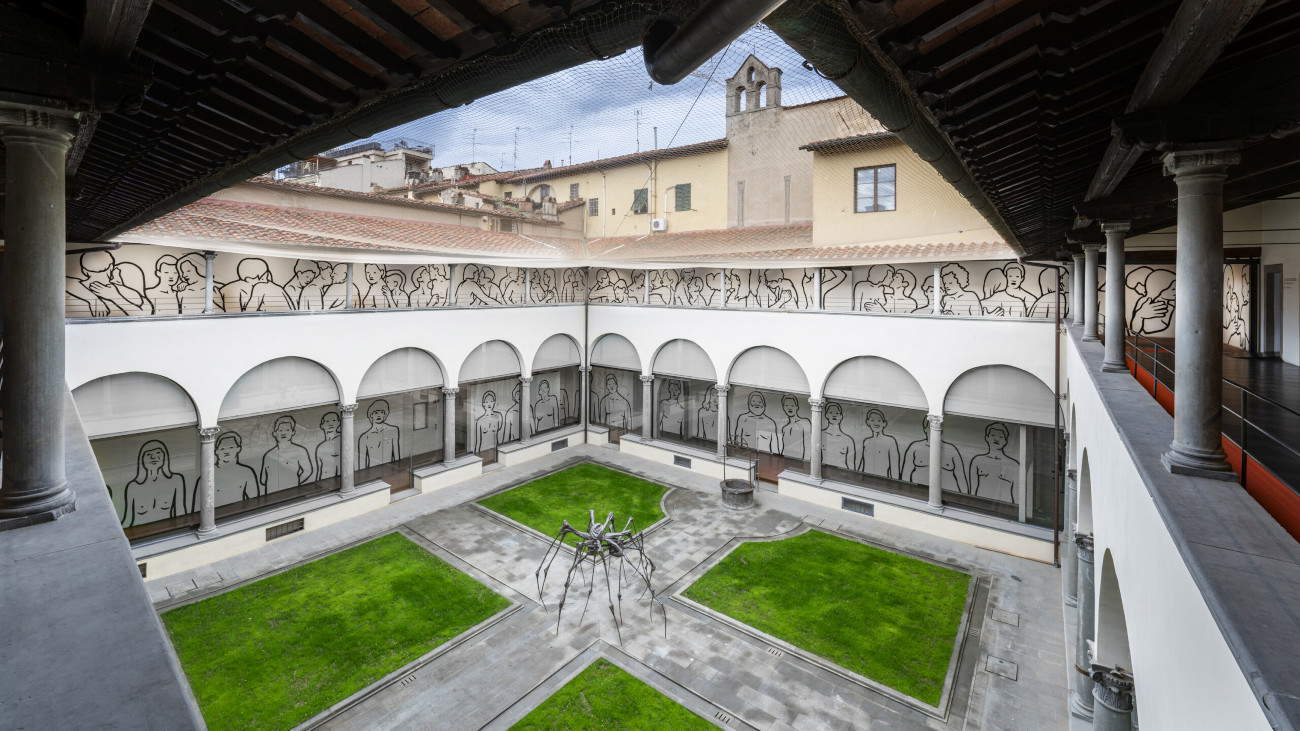Created a site-specific work about eroticism and affectivity for the Novecento Museum in Florence, Italy
On the occasion of the 10th birthday of the Museo Novecento in Florence, director Sergio Risaliti invited MP5 to create asite-specific work for the museum. The work entitled The Third Dimension takes the form of an imposing ribbon of black and white figures painted directly on the walls of the Museum’s two loggias, extending from the ground floor to the second floor. The Third Dimension is a unique work divided into two sections. The first is a sequence of figures painted strictly in black and white that occupy the walls surrounding the cloister of the former Leopoldine with a certain solemnity, from top to bottom. Presented standing and frontally side by side, they seem suspended and solemn in a kind of spatial and temporal limbo. The structure is paratactic and is similar to that of classical or medieval friezes and compositions, as in the Theory of Prophets, Virgins and Martyrs in the mosaics of Sant’Apolinnare Nuovo in Ravenna. As in the ancient works, each of these figures seems to inhabit its assigned space perfectly, capturing the sacredness of the place, over the centuries dedicated to reading and prayer, enhancing subjectivity in its being a fluid multitude. In the loggia on the upper floor, the paratactic structure gives way to an interwoven ribbon choreography of figures linked with each other who brush against each other, embrace each other, kiss each other. An unrolling of desires and affectivity without interruption, where everything is expressed in fullness, with gentleness and sincerity without limitation, shame, imposition.
From the juxtaposition of the two chapters of this narrative of bodies and gestures, rendered with a few synthetic strokes of color, there is a clear perception of movement, physical, emotional and spiritual. Two specular choreographies in dialogue with each other, composing a single performance at the center of which is placed the body of everyone, of each of us, an affective core of care intimacy and desire. The bodies, from static become dynamic fields, which become entangled by staging a movement that restores the power of physical encounter, closeness, exploration of one’s own subjectivity and deepest desires, beyond the interdicted and removed. Knowing that each of these figures and gestures is part of an archive of images extracted from the porn filmography makes us understand how at the center of MP5’s poetic vision is the beauty of desire, the sacredness of subjectivity and its body, the sweet power of love that cancels the distance between what is human and what is divine. MP5’s heterogeneous bodies do not speak of sexual consumption but of eroticism and affectivity, of a new loving order built by relationships that are not homologated and not subjected, consciously or unconsciously, to the punitive regime of social and cultural conditioning.
MP5, whose communicative power is known both in Italy and abroad, has created a work that defies simple categorization. His style, incisive and radical, is unmistakable and leaves a lasting impression. Refusing to be confined to specific genres or schools, his work embraces an open and inclusive visual language that communicates with delicacy and poetry without compromise. Through an aesthetic of refined visual culture, MP5 speaks to the multitude, showcasing the sensuality of intimacy and the eroticism of difference, expressed naturally and without shame.
The project, on view through Oct. 20, 2024, is curated by Sergio Risaliti and Jacopo Gonzales.
Image: MP5, The Third Dimension. Courtesy of the artist and Museo Novecento, 2024. Photo by Ela Bialkowska OKNO studio.
 |
| Created a site-specific work about eroticism and affectivity for the Novecento Museum in Florence, Italy |
Warning: the translation into English of the original Italian article was created using automatic tools. We undertake to review all articles, but we do not guarantee the total absence of inaccuracies in the translation due to the program. You can find the original by clicking on the ITA button. If you find any mistake,please contact us.




























